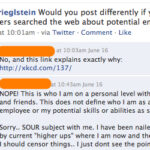We exist in overlapping, intertwined social networks: family, friends, neighbors, church groups, hobby acquaintances, Christmas card friends, etc., etc. It’s an old human thing, we’ve always been that way.
We get emotional well-being from close family and friends. We get growth from topic groups. We need well-being first, then growth, it’s Maslow’s hierarchy.
When a college adopts a new, incoming student, the student’s networks are paramount. The student goes through the official stages:
Contact -> Admissions -> Orientation -> Classs (First Year Experience) -> Advising
Through this college entrance process, students will be negotiating a dramatic shift in their networks. The process can be tricky. When I did it, I felt dislocated and uprooted. It’s often different now.
Schools, through various methods, have always tried to help. Student ambassadors, shared interest residence halls, learning communities, multi-day orientation, and ice breakers are all examples of social capital creation efforts. There are many more.
The goal is simple – get the student in and help them find their niche. Connectedness, Tinto always says, leads to retention. It also leads to student success.
The feelings are the same; the tools have changed.
Facebook was built as a tool to help us manage our overlapping networks. It makes the whole process substantially easier, delivering similar social and emotional oomph with far less work. A simple status update from the cell phone instead of 150 stamps to lick at Christmas. (Remember those days?)
Facebook, et al., as social networking tools, allow us to carry more people in our networks. While most people, prior to Facebook and internet tools, topped out at roughly 150 people across their networks, now many college students, with Facebook, carry 300 or so with little effort. It’s not unusual to see two or three times that number.
This dramatic expansion of our social network carrying capacity is a huge deal. To review, comfort comes from close friends and stronger ties, while learning comes from bridging capital, the weak ties.
Both strong ties and weak ties work differently now, because of the shift in tools.
Students just do it. It’s up to the schools, and the rest of us, to figure out what it means and find new opportunities to help.
Let’s start with the changes to close friends or bonding capital.
It’s not what it used to be.
When I went to college across the country, I had to find new close friends. Back in my day, I could call my old friends (though they had to actually be home, cell phones weren’t yet ubiquitous), or write letters (email caught on later in my freshmen year), but these occasional contact points always felt inadequate. To be emotionally sound, I clearly needed to move on from my old friends. I needed a new core group to build my confidence on. The lack of close friends was painful. It took me a while to realize this, and I did not do the transition well. If it wasn’t for my family, I could have easily been one of that 30% that drop out in their first year.
With Facebook and the current first-year student, the game is different. Their close friends are simply kept on Facebook. There is still a desire for face-to-face friends, certainly, but the connection to the old networks can be maintained with video, status, pictures, and wall posts. The old network can be maintained without any additional effort. If “social” goes through Facebook, it costs nothing to have extra people watching. It’s not face to face, but it’s substantially easier to maintain connection and caring with the cell phone and the tools of Facebook than the tools I had in 1994. (Just look at the number of parents who want to “friend” their own kids to stay in touch. They wouldn’t complain so loudly about being rejected if they didn’t have a sense of the richness.)
It’s rich enough to “feel” – to maintain a sense of identity in a group and to maintain the social foundation of a group of good friends.
There is diversity of course. Some students never had good friend networks in high school. They never had a social foundation to maintain. Some students are so confident that they are nearly self-contained. These are both extreme ends of the spectrum. The tools shift the middle of the bell curve.
Just look what a tool change did to parents. Helicopter parenting became feasible with cell phones. Prior to that tool, helicoptering, for the majority, was simply too much effort. It was almost impossible before answering machines.
The tool changes the need.
For most students, it’s no longer step one to find close friends. That will still happen, given enough face time, we can’t help ourselves, but for most students, it’s not the “make friends with anyone” need that I had when I got to college.
When current students switch to a new place, they don’t have to start over at the bottom of Maslow’s.
Instead, college students are picky.
They want to find people like them.
They want easy conversation because they both love “x”. And why should they settle for less? They are used to the web, where they find the video they want with a few clicks. They’re used to search.
Emotionally, because their friends and family are still “with” them, they don’t feel the pain that would justify lots of awkward face time to fix. They feel good enough and because of this, many more students are ready to group up. They’ve been trained to expect this will be an easy thing because it is easy online.
They try Facebook, but as I’ve said before, each question pushes down the one in front of it. It’s the wrong interface. Facebook is not designed for finding new people, it’s designed for managing the people you know.
So they’ll try all kinds of things all over the web: Twitter, Zinch, Unigo, and one hundred others, but few of these will have enough adoption to make the search useful.
Colleges have an incredible opportunity to fill this need in their orientation process. It will help retention and it will accelerate positive social capital development.
Here’s the rub. Most schools don’t know who the students are. They don’t know enough about the students to make the “people like you” introduction. What the school does know, from admissions essays and other input, is buried, often in separate departmental systems, locked up in FERPA realities or misplaced fears.




